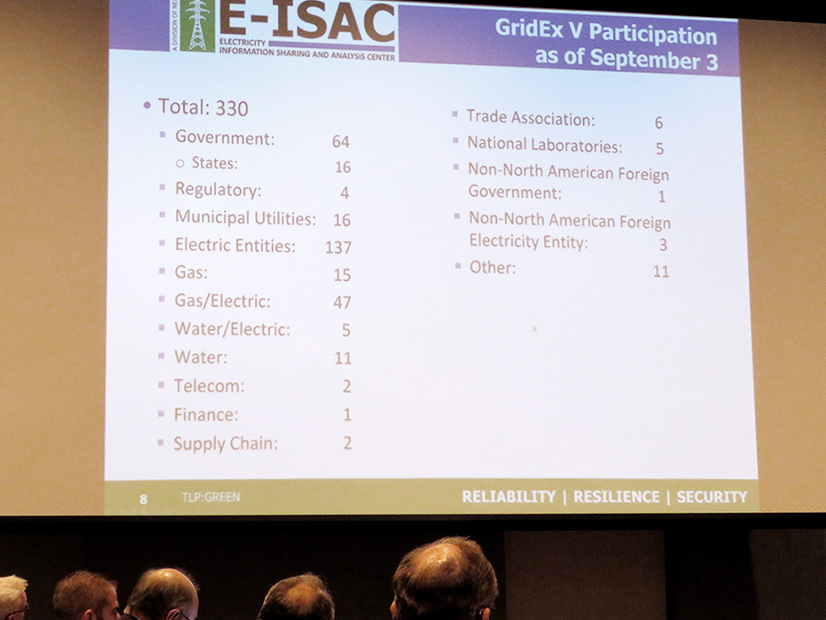The ERO will hold its final planning meeting for GridEx VI from 1 to 3 p.m. ET on May 26. All registered GridEx planners are invited to attend the session, Katherine Ledesma, of the E-ISAC, told the Real-Time Operating Subcommittee (RTOS) at its meeting Wednesday.
“The final planning meeting is a significant milestone for us,” she said.
The biennial exercise is scheduled for Nov. 16-17.
NERC will be circulating the final planning materials this month, including the master scenario events list, inject supporting material and planner resources. Darrell Moore, NERC director of situation awareness, said surveys were sent out on Wednesday to entities to determine which will be participating.
Jimmy Hartmann of ERCOT asked whether the exercise will be “mostly a cyber event, or is operations going to be involved too?”
“Each entity can choose which injects [and scenarios] they want to play,” Ledesma responded. “The scenario and the injects do cross both cyber and physical and do include operational impacts.”
RTOS Chair Chris Pilong, of PJM, suggested that reliability coordinators could benefit from sharing the entity-specific injects they are planning to test against.
“What we’re doing at PJM may not be relevant for a number of other entities participating. But amongst reliability coordinators there might be some value in seeing what others are doing just for ideas in that planning,” he said.
“We would love to hear from reliability coordinators on how they’re doing that,” Ledesma responded. “We have heard several different approaches that the RCs are taking. I know some are very sophisticated in the way they coordinate with organizations within their footprint.
“It would be really helpful for us to hear and learn from you how you’re planning to play, especially this year. It’s a very unique year of remote work and the changes in the way we are doing our normal day-to-day [tasks].”
Update for Cyber Intrusion Guide
In reviewing the RTOS’ 2021 work plan, Pilong asked for volunteers to work on the three-year update for the cyber intrusion guide for system operators.
First drafted in 2018, the guide is intended to “provide some guidance for the system operators about what to do if they’re observing unusual behavior on the system, because we know they may be the first line of defense,” Pilong explained. “And in some cases [they are] the first people to see some of these impacts if a bad actor manages to get past some of the cybersecurity firewalls and other protections that are in place.”
The guide, which will be revised to add lessons learned since the initial draft, will be brought back to the committee for review in September.
Sam Chanoski, technical relationship manager for Idaho National Laboratory’s Cybercore Integration Center, and Asher Steed, of BC Hydro, agreed to take part in the revision. “I think it’s a pretty good resource for system operators, so I’d be happy to be part of the team to go through it,” Steed said.
Pilong said the RTOS also is likely to get work from the Energy Reliability Assessment Task Force (ERATF), which is looking at reliability impacts from the changing resource mix and changing load patterns.
NERC’s Stephen Crutchfield said an ERATF white paper identified 11 questions for understanding energy adequacy. “Of those 11 items, almost all of them are going to be brought to RTOS for their input,” he said.
Endorsements
The RTOS also approved updated reliability plans by SERC Reliability, PJM, SPP and the Florida Reliability Coordinating Council, and endorsed a revised reliability guideline on gas and electrical operational coordination considerations, which is undergoing a triennial review.
The revised gas-electric guideline received 60 comments, most of which were incorporated into the current draft. It would expand references to electric-powered gas compressors, noting, “In the event that critical gas system components are subject to load shedding, or even uncontrolled loss of load, consideration should be given to the priority or restoration in the restoration plan for that equipment. Fuel delivery infrastructure restoration may be necessary to fully utilize all aspects of a full restoration plan.”
As a guideline, “it doesn’t necessarily have to be implemented. It’s not enforceable,” said ISO-NE’s Mike Knowland, who helped write the 2017 draft and the update. “It’s not required. But it’s not a bad idea to think about.”
[Editor’s Note: An earlier version of this article incorrectly described Sam Chanoski as director of threat intelligence for NERC’s E-ISAC. Chanoski left NERC in June 2020.]



